
Figure 33 Cable protection system on vessel deck, courtesy of Tekmar.
Function
Cable protection provides protection to cables at vulnerable locations, from the wave and tidal action and when the cable enters the wind turbine or offshore substation aperture or J-tubes.
Who supplies them
Suppliers for cable protection include Balmoral, CRP Subsea, First Subsea, Subsea Energy Solutions Subsea Protection Systems, Tekmar, Trelleborg, Protectorshell, Vos Prodect and WT Henley.
Key facts
J-tube seals provide a seal at the ends of the J-tube to prevent seawater entering the J-tube. Passive seals consist of a series of disks that are pulled up into the J-tube. Active seals require inflation after they have been pulled through into the J-tube, requiring a remotely operated vehicle (ROV). Seals are not used in all cases, but a sealed J-tube may be filled with a corrosion inhibitor.
Some suppliers offer a J-tube-less solution for monopile foundations by providing a clamp that enables the cable to be routed through a hole in the monopile.
Bend stiffeners are conical devices fitted over the cable that limit the movement of the cable to a permitted range (dependent on the cable’s minimum bend radius). These are typically fitted at connection points such as the J-tube.
Bend restrictor prevent damage caused by excessive bending between flexible cable lengths and fixed structures such as the turbine foundation. Protection from bend stiffeners is only applied when a set bend radius is reached. At this point bend restrictors lock to avoid further bending.
Abrasion, touch down and impact protection are provided by protection matting and protection sleeves. These protect the cable where it lies exposed on the sea bed, where it enters or exits the sea bed, or where it crosses other cable routes.
What’s in it
- J-tube seals
- Bend restrictors
- Bend stiffeners
- Cable mattresses
- Rock placement